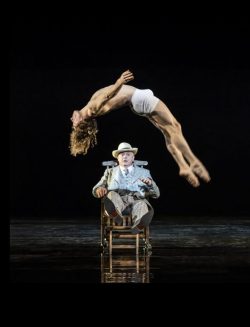 A COCKTAIL of Thomas Mann’s semi-autographical novella Death in Venice, a Benjamin Britten score composed in the last months of his life, and the tumbling, mime and balancing skills of circus performers looks like a guaranteed mixture for a disastrous opera production. But if you add in the imaginative talents of director Olivia Fuchs, designer Nicola Turner, lighting and video designers Robbie Butler and Sam Sharples, plus circus consultant Tom Rack, this prospectively toxic mixture turns into an exciting theatrical experience.
A COCKTAIL of Thomas Mann’s semi-autographical novella Death in Venice, a Benjamin Britten score composed in the last months of his life, and the tumbling, mime and balancing skills of circus performers looks like a guaranteed mixture for a disastrous opera production. But if you add in the imaginative talents of director Olivia Fuchs, designer Nicola Turner, lighting and video designers Robbie Butler and Sam Sharples, plus circus consultant Tom Rack, this prospectively toxic mixture turns into an exciting theatrical experience.
It is easy to see why Britten’s heartfelt score fits into Mann’s story, especially when the formidable tenor Mark Le Brocq is on hand to bring the frustrated, mentally tired writer Gustav von Aschenbach to life. But how do you turn the beautiful young man, Tadzio, who reawakens von Aschenbach’s writing process and makes him face his true sexual identity, into a circus acrobat a without fundamentally damaging the image of Mann’s vividly drawn character. The answer is by having a highly skilled circus performer, mime artist and dancer, Antony Cesar, on hand to use those combined assets to enhance every nuance in the thought rather than physical coming together of the writer and the beautiful boy.
There are moments when Anthony and his family of three fellow circus artists take over the production, creating moving images of great beauty, leaving Britten’s score as mere incidental music. But this is never to the detriment of the production or loss of the essential nervous edge to the story, because waiting to pickup the baton is Mark Le Brocq’s agonising Gustav von Aschenbach. Virtually never off stage, acting as observer when not driving the story forward, Le Brocq displays remarkable concentration, never slipping out of character for a moment. Not even a hiatus front of house which caused a 15 minute delay in proceedings dented this concentration. He along with the rest of the cast and the orchestra picked up the production as if there had never been an interruption.
Playing Britten’s complex, often sharp-edged score to fit the singers is a difficult task, to do so in order to fit dancers and circus performers as well demands special skills, which the WNO orchestra had, above and beyond the usual area of expertise. There was no question here of a larger-than-life conductor demanding attention upon his input, instead Leo Hussain slipped into the fray almost unnoticed to keep a firm and sympathetic hand on proceedings throughout.
Purists who place Britten’s music above all else in this opera may have some cause for complaint, fans of Mann’s novella should be pleased with this unique but faithful interpretation of his story, and neutrals can just sit back and admire this new production, first seen in March of this year, and hope that it will remain in the repertoire for many years to come, bringing joy to regular supporters of WNO and introducing many newcomers to a unique operatic production.
GRP